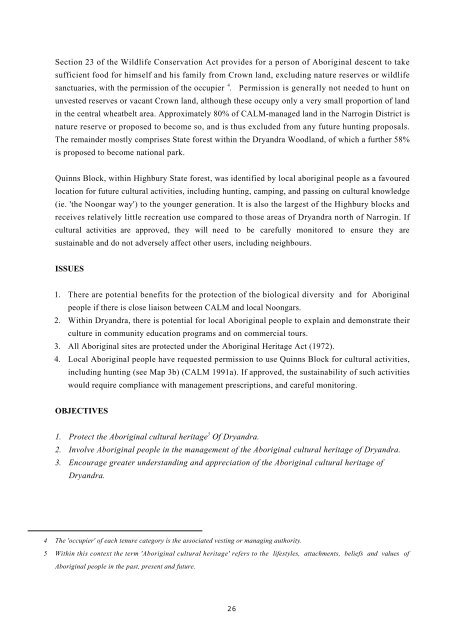Dryandra Woodland - Department of Environment and Conservation ...
Dryandra Woodland - Department of Environment and Conservation ...
Dryandra Woodland - Department of Environment and Conservation ...
Create successful ePaper yourself
Turn your PDF publications into a flip-book with our unique Google optimized e-Paper software.
Section 23 <strong>of</strong> the Wildlife <strong>Conservation</strong> Act provides for a person <strong>of</strong> Aboriginal descent to take<br />
sufficient food for himself <strong>and</strong> his family from Crown l<strong>and</strong>, excluding nature reserves or wildlife<br />
sanctuaries, with the permission <strong>of</strong> the occupier 4 . Permission is generally not needed to hunt on<br />
unvested reserves or vacant Crown l<strong>and</strong>, although these occupy only a very small proportion <strong>of</strong> l<strong>and</strong><br />
in the central wheatbelt area. Approximately 80% <strong>of</strong> CALM-managed l<strong>and</strong> in the Narrogin District is<br />
nature reserve or proposed to become so, <strong>and</strong> is thus excluded from any future hunting proposals.<br />
The remainder mostly comprises State forest within the <strong>Dry<strong>and</strong>ra</strong> <strong>Woodl<strong>and</strong></strong>, <strong>of</strong> which a further 58%<br />
is proposed to become national park.<br />
Quinns Block, within Highbury State forest, was identified by local aboriginal people as a favoured<br />
location for future cultural activities, including hunting, camping, <strong>and</strong> passing on cultural knowledge<br />
(ie. 'the Noongar way') to the younger generation. It is also the largest <strong>of</strong> the Highbury blocks <strong>and</strong><br />
receives relatively little recreation use compared to those areas <strong>of</strong> <strong>Dry<strong>and</strong>ra</strong> north <strong>of</strong> Narrogin. If<br />
cultural activities are approved, they will need to be carefully monitored to ensure they are<br />
sustainable <strong>and</strong> do not adversely affect other users, including neighbours.<br />
ISSUES<br />
1. There are potential benefits for the protection <strong>of</strong> the biological diversity <strong>and</strong> for Aboriginal<br />
people if there is close liaison between CALM <strong>and</strong> local Noongars.<br />
2. Within <strong>Dry<strong>and</strong>ra</strong>, there is potential for local Aboriginal people to explain <strong>and</strong> demonstrate their<br />
culture in community education programs <strong>and</strong> on commercial tours.<br />
3. All Aboriginal sites are protected under the Aboriginal Heritage Act (1972).<br />
4. Local Aboriginal people have requested permission to use Quinns Block for cultural activities,<br />
including hunting (see Map 3b) (CALM 1991a). If approved, the sustainability <strong>of</strong> such activities<br />
would require compliance with management prescriptions, <strong>and</strong> careful monitoring.<br />
OBJECTIVES<br />
1. Protect the Aboriginal cultural heritage 5 Of <strong>Dry<strong>and</strong>ra</strong>.<br />
2. Involve Aboriginal people in the management <strong>of</strong> the Aboriginal cultural heritage <strong>of</strong> <strong>Dry<strong>and</strong>ra</strong>.<br />
3. Encourage greater underst<strong>and</strong>ing <strong>and</strong> appreciation <strong>of</strong> the Aboriginal cultural heritage <strong>of</strong><br />
<strong>Dry<strong>and</strong>ra</strong>.<br />
4 The 'occupier' <strong>of</strong> each tenure category is the associated vesting or managing authority.<br />
5 Within this context the term 'Aboriginal cultural heritage' refers to the lifestyles, attachments, beliefs <strong>and</strong> values <strong>of</strong><br />
Aboriginal people in the past, present <strong>and</strong> future.<br />
26

















